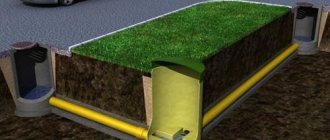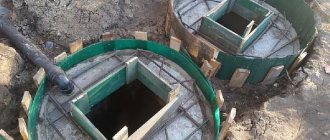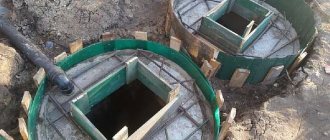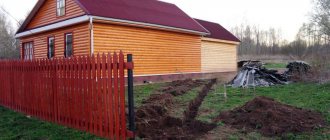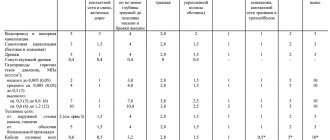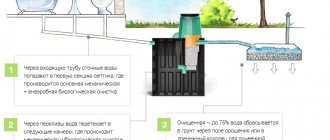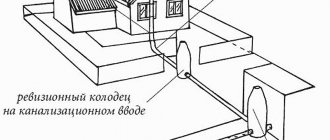26.02.2021
Sewerage
Editorial staff of the “New Place” website
Share
From this article you will learn
:
- The need to determine the depth of sewer installation
- Depth of sewerage installation according to SP 2.04.03–85
- Minimum depth of sewer pipes
- Maximum laying depth of sewer pipes
- Basic rules for determining depth
- Soil freezing depth
- Pipe material
- Pipe diameter
- Water temperature
- Additional insulation
In order for the drainage system in a country cottage to work properly for a long time, it is important to correctly calculate the depth of the sewer system. This parameter also affects the cost of pipeline installation.
This means that the system should be installed at a depth so that it meets the technical requirements of your region of residence, without being too large. However, it is worth considering not only this factor so that the operation of the sewage system occurs without problems.
Sewage systems of private houses
In the development of suburban areas, autonomous sewage systems are often used, which are distinguished by the presence of a large number of positive qualities.
Some systems turn out to be more economically advantageous than using a central sewer, while others turn out to be the only possible solution to the sewage problem. For the normal functioning of external sewerage and ensuring quality service, the design of the system must be arranged in accordance with the rules and regulations reflected in regulatory documents.
The installation scheme of the sewer system and its operation largely depend on factors, which include:
- topographic indicators of the selected territory;
- types of soils located on the site;
- availability of water supply sources near the site;
- layout diagram of underground engineering networks that are already present on the territory.
The sewage system can be quite simple: the simplest design consists of a single section of pipeline that transports wastewater to a pit or septic tank located outside the building. You need to know at what distance from the house to install a septic tank. The simplest septic tank can be made from car tires stacked vertically on top of each other: the wastewater will still be filtered, and the solid fractions will be periodically pumped out by a sewer truck. This design is well suited for installation in suburban or small urban areas. For the sewer system to work normally, it is enough to provide a constant slope and periodically pump out.
It is much more difficult to install a sewer system in an area that has complex terrain or where there is a source of drinking water. In this case, the sewage system must comply with the sanitary requirements that apply to septic tanks or waste storage tanks. In addition, the design of the system can be complicated by connecting the drainage system and storm drainage to it.
Optimal depth
In practice, the most common depth of a sewer pipe at the exit of a building is from 50 cm in the southern to 100 cm in the northern regions. The following factors may affect the depth of placement:
- The pipe runs under the road, then it is buried as deep as possible.
- The building has a shallow foundation. During construction, no hole was provided for the pipe outlet. Then the pipe is laid below the foundation so as not to drill a hole in the concrete.
- The site has uneven terrain with steep elevation changes. It may turn out that the depth in different places will vary greatly. The slope of the pipe will have to be steep.
- For some reason, the septic tank is installed shallowly, then they try to lay the pipe as high as possible.
The depth of the septic tank is determined individually for each site, taking into account local conditions. The factor of freezing of wastewater in the tank itself is not taken into account. the following reasons:
- Factory septic tanks, as a rule, are about 2 m high. The earth at such a depth retains heat throughout the cold season (for this reason, it is warm in cellars and basements in winter).
- Warm wastewater regularly flows into the septic tank.
- Biological decomposition reactions of organic matter in wastewater generate additional heat.
During severe frosts in the northern regions, a septic tank buried in the ground can be insulated on top with snow or any insulation used in construction.
Distance between inspection wells according to SNiP
It is necessary to install inspection wells in the following situations:
- in the presence of an extended pipeline running in a straight line;
- when there are turns or bends in the pipeline, as well as when the diameter of the pipes changes;
- in the presence of branches of the structure.
The function of inspection wells for sewerage is to monitor the system and the ability to gain access to its interior for maintenance.
SNiP determines the distance between sewer wells, and according to it, the following rules must be followed:
- with a pipe diameter of 150 mm, wells are installed every 35 meters;
- 200-450 mm – 50 m;
- 500-600 mm – 75 m.
A further increase in the diameter of the pipes allows the maximum distance between sewer wells to be increased even further.
However, the likelihood of such a design appearing on a summer cottage is extremely low, because the volume of wastewater produced by 3-4 people does not require wide pipes. The use of large pipes may be justified if absolutely all wastewater passes through the sewer system: precipitation, water from the bathhouse, and waste directly from the residential building. As a rule, when arranging private sewer systems, pipes with a diameter of 100 mm are used.
When using them, SNiP determines the distance between sewer wells to be 15 m. If the sewerage system does not have bends or branches, and the diameter of the pipeline does not change throughout its entire length, then the distance can be increased to 50 m.
Why is depth important and why are mistakes dangerous?
The pipe is buried too shallow
Fast-flowing warm drains cannot freeze even in severe frosts. However, some waste may remain at the bottom of the pipe. If the pipe is not buried deeply, these residues freeze in severe frosts. The next time you drain the warm water from the bath, they can be melted and washed away. But if the drain is small and cold (from a toilet or sink), a layer of ice may build up even more. So within a few times the mouth of the pipe can become completely clogged with ice.
Slope calculated incorrectly
If the pipe slopes slightly towards the septic tank, the water stagnates and does not drain well even in summer. In winter, this stagnant water can also freeze and block the drain completely.
The pipe is buried too deep
Its end enters the lower part of the septic tank, and this impairs the discharge by gravity. The level of wastewater in the septic tank will always be higher than the pipe. In this case, the wastewater will leave the house, but weakly, according to the law of communicating vessels, and not through an active one-time discharge. And this can lead to stagnation of wastewater in the pipe, the deposition of solid organic matter, clogging the drain. In winter, the drains in such a system can also freeze.
The pipe is laid in an arc, hump up or down
In both cases, drainage will be difficult, water will stagnate, silt deposits will accumulate, and the system may freeze in winter. An unpleasant odor can penetrate into the house from all siphons.
Rotary wells for sewerage
This type of wells in its purpose and design is absolutely identical to inspection wells, with the only difference being that rotary wells are installed in places where the direction of the pipeline changes. Sharp bends with large turning angles are usually the areas most likely to become clogged and require special attention. This is precisely the function that rotary wells perform.
The distance between rotary sewer wells is usually calculated based on the length of the straight sections between the bends of the pipeline. If the pipeline section is longer than specified by the regulatory document, then it must be equipped with inspection wells in order to ensure a sufficient level of control over the operation of the system.
Drop wells
Installing sewerage in an area with difficult terrain is quite a troublesome task.
If the area has a noticeable slope, then the slope of the pipeline will also be appropriate, which is absolutely not allowed: wastewater moving at high speed will gradually settle on the walls of the sewer system, thereby clogging it and rendering it unusable. Regulatory documents in this case speak of the need to install differential wells, which are installed in stages and compensate for the high speed of waste transportation, saving the structure from blockages (more details: “Difference sewer wells are an important necessity”).
SNiP does not determine the specific distance between sewer wells in this case, but imposes some requirements on the design:
- firstly, the height of one drop should be less than three meters;
- secondly, with differences up to 0.5 m deep (when using pipes with a diameter of up to 600 mm), differential wells can be replaced with inspection wells using drains.
You should always remember that any sewer system ends at a spillway point, at which there is necessarily a final well, which requires an inspection hatch.
The importance of choosing the correct drainage slope
In most cases, when planning storm drainage systems, preference is given to gravity systems. In such options, the movement of wastewater is carried out by natural gravity. In order for such a system to function properly and without interruptions, care should be taken to lay the pipes at a certain slope. After all, normal operation of the sewer system is possible only if the slope is correctly executed. The slightest mistake in this matter can lead to the failure of waste liquids to pass through and the formation of blockages. But you shouldn’t count on the fact that the greater the slope, the faster the drains will drain. With a fairly strong slope, flooding and breakdown of water locks may occur. Do not forget that the system must be constructed in such a way that the lowest point is at the entrance to the septic tank.
Another significant point is that the slope level is expressed not in degrees, but in centimeters per linear meter. This is due to the significant length of the pipeline and possible errors.
Other standards
In addition to the standards described above, which are often a problem for owners of private plots due to their inaccessibility, there are others that also need to be followed in order to avoid problems with the functioning of the sewage system in the future.
For example, the minimum distance from the sewer well to the building should be 3 m, and the maximum - 12 m, regardless of the type of well used. The distance from the house to the sewer well is a rather important indicator that must be observed. It is important to consider the distance from the cesspool to the well. In addition, you must always remember the existence of sanitary standards that determine the removal of elements of sewer systems from reservoirs, water sources, vegetable gardens and orchards. Conclusion
Installing a sewer system on your own property is not a big problem.
All installation work related to laying pipelines and arranging sewer structures is quite simple and can be performed by any homeowner. You can find other articles on this site about all types of work, and then everything will become extremely clear. Compliance with the rules and regulations reflected in the relevant documents is a prerequisite for ensuring the normal functioning of the sewer system. If you do not follow the rules, the structure will regularly fail, become clogged, and its repair and maintenance will become much more complicated. Correct installation of sewer wells will help prevent possible problems and provide high-quality access to all sections of the structure. If the distance between the storm sewer wells is maintained, then monitoring the performance of the system will be much easier (pro
Storm drain equipment
Point storm drainage is equipped with a standard set of elements.
- Storm water inlets are mostly plastic, less often concrete containers, installed directly under the drainpipe.
- Branches are specialized two-layer pipes or pipes for external sewerage, laid underground, through which wastewater is discharged outside the site or to a collection point. Bends can also be of an open type, in the form of polymer or concrete trays with gratings, homemade ones made from asbestos-cement or polymer pipes dissolved in half, or simply ditches dug in the ground.
- Water intakes - if we are talking about country cottage settlements, rural settlements or gardening partnerships, they usually have a common rainwater drainage system in the form of drainage ditches along the boundaries of the plots. In this case, the outlets discharge water outside the yard. Less often, a drainage ditch is located directly on the site, in a lowland; it can also be a functional and decorative dry stream or pond. In the absence of this, storm sewer effluent is directed to a receiving absorption (drainage) well, where it settles, filters through a layer of crushed stone and is gradually absorbed into the ground. Another option is storage storm wells, which are pumped out as accumulation occurs using special drainage pumps.
Linear storm drainage is usually performed not instead of, but together with point drainage, in order to increase the efficiency of drainage of the area. In this case, open ready-made or homemade trays are added to the rainwater inlets. They are installed along blind areas, garden paths, in the parking area and in places where water accumulates around the site.
